- Home
- SUSTAINABILITY
- Environment
- Reducing our Environmental Footprint
Reducing Our Environmental Footprint
The activities of all living things, including people’s life and economy, rely on the bounties of nature. Since the foundation of Shiseido, we have positioned respect and gratitude for the blessings of the earth at the core of our business. In recent years, the impact of economic activities on the environment, such as climate change, the loss of biodiversity and plastic pollution, has been felt around the world and has become too big to ignore. To become the world’s most trusted beauty company and remain vital for the next 100 years and beyond, the simultaneous pursuit of environmental sustainability and the growth of business must be a priority. Consequently, we identified issues from a value chain perspective and set long-term targets for reducing our environmental footprint. Initiatives have been introduced throughout the business.
We are taking steps to reduce CO₂ emissions not only at our sites but also across our entire value chain (indirect emissions) to mitigate and adapt to climate change. We are also working to minimize climate change-related risks to our business while at the same time maximizing opportunities for business. In terms of water resources, we have reduced water consumption at our sites to ensure that water is used sustainably by working with stakeholders in the basins within which our sites are located. Waste is sorted based on the principles of the circular economy to ensure that resources are used in the most efficient way.
Reducing CO₂ Emissions
Climate change is leading to numerous environmental issues, including meteorological disasters, a water shortage and the loss of biodiversity, as well as social issues, such as health damage and inequity caused by the loss of land. Countries and regions around the world have agreed to the global goal of holding the increase in global average temperature to below 1.5°C above pre-industrial levels and to achieve net zero emissions. In 2024, the increase in global average temperature reached a record high of 1.55℃, indicating that further efforts to reduce CO₂*1 emissions are required, not only at the national and regional levels, but also in corporate activities.
Shiseido supports the Paris Agreement and the Glasgow Climate pact, and has set response to climate change as its important task. To achieve our long-term objective, net zero emissions in 2050, and achieve our medium-term 2030 target, we have set CO₂ emissions reduction targets aligned with the 1.5°C trajectory, by following the Science Based Targets*2 initiative. We have obtained certification from the SBTi. We are driving initiatives to reduce CO₂ emissions, such as switching to renewable electricity, reducing the use of energy and improving energy efficiency. We are also working with stakeholders to reduce indirect CO₂ emissions from the value chain (Scope 3 emissions).
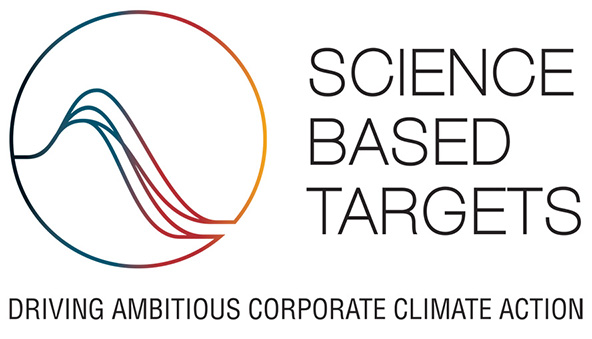
- *1:Greenhouse gases usually refer to CO₂, CH₄, N₂O, HFCs, PFCs, SF₆, and NF₃. In this report, unless otherwise specified, these greenhouse gases will be collectively referred to as ‘CO₂’.
- *2:Scope 1, Scope 2 and Scope 3 emissions. Certification was obtained from the Science Based Targets initiative (SBTi).
Reducing CO₂ Emissions from Energy Consumption (Scope 1 and Scope 2)
It is necessary to reduce the impact of our business activities, and accordingly, the CO₂ emissions across our entire value chain. To lay the groundwork for this, we are steadily reducing CO₂ emissions from the electricity and fuel used at our sites.
Increasing the Use of Renewable Electricity
We are constantly working to increase the use of renewable electricity at all of our factories, offices and research centers. Renewable electricity accounted for 89% of all the electricity used at Shiseido Group in FY2024. We switched 100% of the electricity at all 11 factories, distribution centers and all of the company-owned buildings of Shiseido Japan to electricity from renewable energy. Ten of our facilities* in different countries and regions are equipped with solar panels. In the China Region, we completed a 100% switchover at all sites in 2023. Moreover, at the Beijing Office, which includes the factory of Shiseido Liyuan Cosmetics Co. Ltd. (SLC) in China, we fulfilled requirements under the code for carbon neutrality certification (PAS 2060:2014) and obtained certification. In addition, Shiseido is a member of the RE100 global initiative, which brings together businesses committed to using 100% renewable electricity in their activities. We will continue to accelerate our transition to renewable electricity in our operations to reduce fossil-fuel derived electricity.
- *Facilities are: Kakegawa (Japan), Osaka Ibaraki (Japan), Fukuoka Kurume (Japan), Shanghai (China), Beijing (China), Hsinchu (Taiwan), East Windsor (US), Gien (France), and Val de Loire (France) (Country/Region) and Global Innovation Center (Japan)
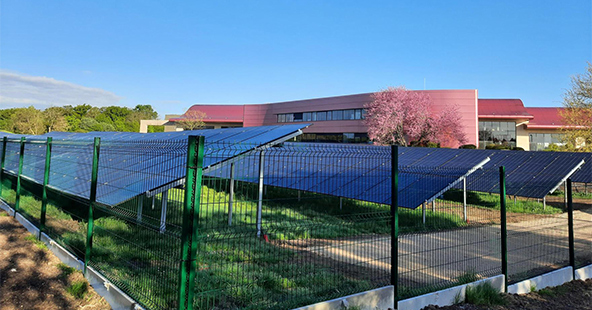
Solar panels at the Val de Loire factory in France
Driving Energy Conservation and Energy Efficiency Improvement
Every year, we set CO₂ emissions reduction targets at all company-owned factories and distribution centers in countries and regions around the world. For FY2025, we are aiming for a 3% reduction in CO₂ emissions compared to the previous year and working to reduce energy consumption. We monitor our progress against the targets on a monthly basis based on our ISO 14001 environmental management system,*1 and take measures as necessary. Specifically, in addition to using LED lighting to reduce energy consumption and electric forklifts to reduce CO₂ emissions, we installed Energy Management Systems (EMS)*2 to visualize the energy use and CO₂ emissions of equipment that uses electricity, steam, or compressed air.
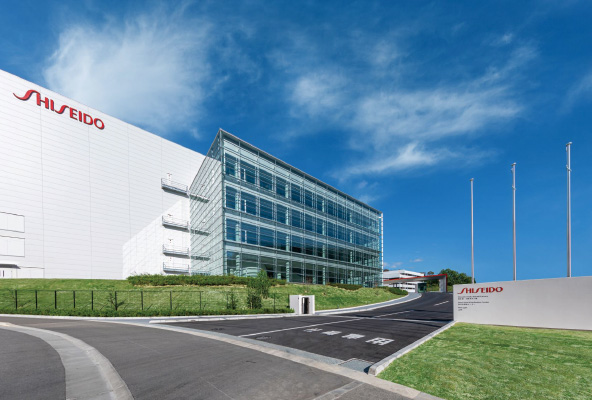
Osaka Ibaraki factory and neighboring West Japan Distribution Center
At our Kakegawa factory, EMS data analysis revealed heat loss during steam distribution from the central energy building to production buildings. By installing heat pumps in each production building, we successfully reduced heat loss and improved energy efficiency. At our West Japan Distribution Center, we installed thermal insulation panels in the exterior walls to help control room temperature. Our distribution center in the United States completed an ASHRAE*3 Level 1 audit, the basic-level building performance assessment.
As part of our internal awareness initiatives, Shiseido provides an e-learning program on sustainability to all domestic employees. This program explains how various business operations contribute to CO₂ emissions and emphasizes the importance of collective action in addressing environmental challenges, including energy consumption reduction and energy efficiency initiatives. A knowledge assessment is conducted at the end of the program to evaluate employees’ understanding.
In manufacturing sites with high energy demands, we offer fundamental training on energy conservation and decarbonization. We also hold regular study sessions for engineering and facility management personnel, focusing on energy-saving practices using our Energy Management System (EMS). These sessions include EMS data analysis, collaborative discussions, and cross-site information sharing, supporting continuous enhancement of expertise in energy-saving activities.
- *1:Promote acquisition of ISO 14001 certification at all factories and distribution centers. (All factories have acquired ISO 14001 certification as of the end of 2023. The West Japan Distribution Center and Taiwan Distribution Center have acquired the certification as of the end of 2024)
- *2:A system that realizes efficient use of energy such as energy saving and load leveling by visualizing the energy usage status using information and communication technology Introduced at all of our domestic factories and some overseas factories (Hsinchu and Val de Loire). It will be introduced at the rest of the overseas factories in due course.
- *3:American Society of Heating, Refrigerating and Air-Conditioning Engineers
Introduction of Internal Carbon Pricing
Approximately 60% of energy-related CO₂ emissions caused in our business are due to production activities at factories. We decided to introduce an internal carbon pricing (ICP) system in 2023 to help make decisions on investments in factory equipment. In 2024, we started to apply the carbon price in the making of decisions on decarbonization investments in energy efficient facilities, renewable energy facilities, and similar facilities.
Initiatives to Reduce Indirect CO₂ Emissions in Value Chain (Scope 3)
It is necessary to understand indirect CO₂ emissions and actively reduce them across our entire value chain.
Since 2011, we started analyzing them by means of a Life Cycle Assessment to assess their indirect CO₂ emissions via the value chain. Based on the results of our continual assessment, we identified the major sources of CO₂ emissions in our business activities and established science-based long-term reduction targets. We are working with stakeholders to reduce emissions across our entire value chain.
Selection and Use of Raw Materials that Reduce Environmental Footprint
We select raw materials that reduce our environmental footprint in line with the green chemistry principles*1. For the procurement of palm oil and paper, we support the principles of the NDPE (No Deforestation, No Peat, No Exploitation), which emphasizes not only environmental considerations but also social aspects such as human rights, ensuring the procurement of sustainable raw materials that do not contribute to deforestation. We are striving to reduce CO₂ emissions related to the development of containers, by promoting the use of recycled resins.
In addition, in 2022 Shiseido participated in the CDP Supply Chain Program*2. The goal is to reduce CO₂ emissions from the upstream supply chain, which account for over 40% of the indirect CO₂ emissions in the value chain. In 2024, we requested 26 strategic suppliers to respond to the CDP questionnaire as part of the program. The obtained data is utilized to calculate and reduce Shiseido's Scope 3 emissions.
- *1:The design of chemical products and processes that reduce or eliminate the use or generation of substances that are hazardous to people or the environment.
- *2:The Carbon Disclosure Project (CDP) Supply Chain Program is an initiative in which member companies use the CDP platform to request that their suppliers disclose information related to climate change, water, and forestry.
Reducing CO₂ Emissions During Transportation
In Japan, we conduct joint deliveries with other domestic companies to optimize transportation routes and improve loading efficiency. We have also introduced more electric trucks into our vehicle fleet. In our exports from Japan to overseas destinations, double stack palletization* further improved loading efficiency.
We are working to reduce waste and CO₂ emissions by optimizing transport packaging and reusing transport protective packaging, focusing on container suppliers with high delivery frequencies. By simplifying transportation materials as much as possible, we also contribute to waste reduction at stores.
Furthermore, we are collaborating with a container supplier to conduct production at the site closest to our production facility.
- * A logistics process consisting of placing goods together on top of a pallet to consolidate the load at the warehouse.
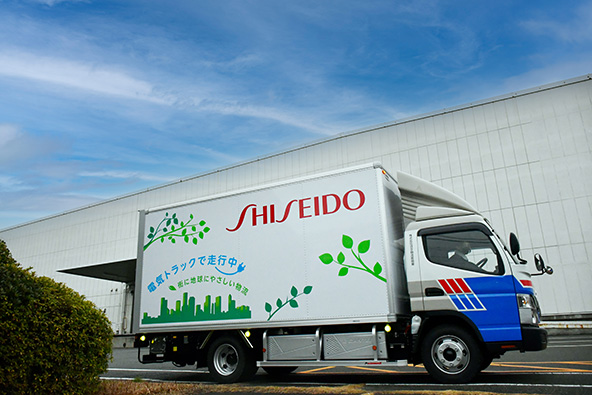
EV truck for Shiseido product distribution
Reducing Waste
As part of our efforts to realize a circular economy, we are working to reduce waste. At Shiseido, we are doing this by optimizing the use of resources and reducing waste throughout our entire value chain, while complying with all relevant waste management laws and regulations in the countries and regions where we operate. We have been working to reduce, reuse, and recycle the waste we generate over the long term. In 2003, we achieved “zero emissions*1” at our factories in Japan, and we continue our waste separation and recycling activities to this day.
We conduct monthly review processes between the headquarters office and each factory to assess the volumes and types of waste generated to work towards reducing waste and enhance recycling efforts. At our domestic factories, we manage waste data based on electronic manifests, allowing monitoring of waste disposal status, ensuring data transparency and strict compliance with regulations. To give a specific example, we dehydrate and dry the sludge generated by our factories during wastewater treatment process to reduce its volume. In addition, at our Nasu factory, we have changed the delivery method of certain liquid raw materials from the use of drum cans to delivery by tank trucks. We have thus reduced the generation of waste drum cans as a waste reduction initiative. We also reuse shipping boxes, sort waste by material strictly for recycling them, and undertake other activities for reusing and recycling waste. In 2023, we entirely reviewed cardboard boxes, plastic packaging, and other packaging containers used for product transportation. We are moving forward with initiatives to minimize the use of resources while ensuring product quality. In addition to paper resources, we also compress and melt waste plastics to reduce their volume, turning them into valuable recycled resources.
As a result of these activities, we achieved our goal of zero waste*2 to landfill across all Shiseido owned factories worldwide in 2020, two years ahead of our target schedule of 2022, and have maintained zero waste to landfill to date.
In addition, we have undertaken initiatives to recycle materials, such as converting used cooking oil into Sustainable Aviation Fuel (SAF) at the Osaka factory and Osaka Ibaraki factory, further supporting the transition to a circular economy.
We are also engaging in various initiatives for waste generated outside of our sites, including streamlining our product containers and packaging, eliminating package inserts, switching to lighter-weight cardboard boxes, and reducing packaging. Moreover, we also work to minimize product disposal resulting from excess inventory through improved precision in demand forecasts and shorter lead times in production and procurement.
- *1:“zero emissions” is a concept defined by UN university in Japan. Recycled waste: 99.5% or higher (excluding waste designated as landfill by law)
- *2:Excluding waste designated as landfill by law.
Employee Education
All our waste reduction initiatives are driven by employees. Therefore, we arrange online seminars and training sessions in Japan for managers and employees in charge of waste management at Shiseido Group companies. These sessions aim to promote understanding of waste management laws and reduction activities. When we outsource the disposal of waste from our factory or office to a waste disposal contractor, we make sure to assess the contractor, ensure that industrial waste is disposed of appropriately, ensure that a manifest is managed, and inform the importance of onsite confirmation to the contractor. Following the seminars and training sessions, each participant should be able to identify how to effectively manage waste with the help of our internal guidelines and checklists, ensuring adherence to legal standards.
Long-term Incentive-type Remuneration for Corporate Officers Linked to Environmental Goals
In FY2019, Shiseido introduced performance-linked stock compensation (performance share units) in consideration of Directors' duties. The compensation that is paid annually is structured to serve as an effective incentive for creating medium-to-long-term corporate value. Social value metrics, one of the evaluation items, are given an evaluation weight of 20%. Social value metrics are comprised of multiple ESG-related performance indicators. The environmental aspect is evaluated according to the status of the achievement of the CO₂ emissions reduction target.
Awards Related to Reduction of CO₂ Emissions
CDP A List <Climate Change and Water Security>
Shiseido was selected by CDP, an international NPO, as one of the companies in the A List 2024 in recognition of its leadership in transparency and performance in the fields of Climate Change and Water Security. We were selected for the third consecutive year in Climate Change and for the first time in Water Security.
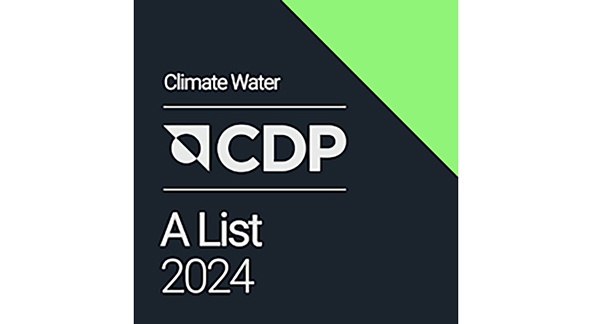
Actions for Scope 3 Emissions by Category
| Category | Explanation | Internal data | Emission factors |
|---|---|---|---|
|
1.Purchased goods and services |
Emissions generated from upstream of the supply chain, such as raw materials, advertising service, land use change due to palm- and paper-derived material production. | Raw material procurement volume POSM procurement volume, Advertising expenses Palm- and paper-related raw material procurement |
IDEA v3.1 Ecoinvent 3.9 Reference-1 Reference-2 |
|
2.Capital goods |
Emissions generated from making capital goods | CAPEX | Reference-1 |
|
3.Fuel and energy related activities |
Emissions generated in the process of mining, extraction, refining, transportation of energy and fuels | Amount of energy consumption | IDEA v3.1 |
|
4.Upstream transportation and distribution |
Emissions generated from procurement transportation, shipping transportation and waste collection | Raw material procurement volume Product volume Distance between our factories and sales sites/Means of transportation |
IDEA v3.1 Ecoinvent 3.9 |
|
5.Waste generated in operations |
Emissions generated in the process of waste treatment from our operations. | Waste generated by material type and disposal method | IDEA v3.1 |
|
6.Business travel |
Emissions from employee business-related travel | Travel expenses Number of trips by destination Transportation distance |
IDEA v3.1 Reference-1 |
|
7.Employee commuting |
Emissions from employee commuting between home and Shiseido’s site | Commuting expenses | IDEA v3.1 Reference-1 |
|
8.Upstream leased assets |
Leased property | Energy and fuel consumption | IDEA v3.1 |
|
9.Downstream transportation and distribution |
Emissions generated in storage and stores | Sales volume Product bottom area |
Reference-4 |
|
10.Processing of sold products |
Not applicable. The products sold do not need to be processed for consumer use | |
|
|
11.Use of sold products |
Emissions from product use, such as rinsing, drying up | Energy, water, and consumable goods consumed in product use | IDEA v3.1 |
|
12.End-of-life treatment of sold products |
Emissions generated in decomposition of ingredients, and the process of transportation and waste treatment from products sold | Amount of carbon derived from fossil resources in the molecules that make up the ingredient and packaging components Waste generated by material type | IDEA v3.1 |
|
13.Downstream leased assets |
Not applicable | |
|
|
14.Franchises |
Not applicable | |
|
|
15.Investments |
Emissions from unconsolidated affiliates and stock investees | Scope 1 and scope 2 emissions of unconsolidated affiliates and stock investees Shareholding Ratio | - |
Calculation methods of Scope 3 emissions
-
1)Emission factor database for calculating GHG emissions of an organization through its supply chain v3.2
-
2)Germer, J. et al. (2008) Environment, Development and Sustainability, 10, 697-716
-
3)Calculation method and Emission Factors for Reporting of Act on Promotion of Global Warming Countermeasures
-
4)The Chain Store Industry's Vision toward Carbon Neutral by 2050
Participation in initiatives aimed at quantifying the industry's overall environmental impact and reducing CO₂ emissions
Shiseido is actively participating in global initiatives related to the cosmetics industry and beyond. Through the development of rules for CO₂ emissions measurement and environmental impact assessment methodologies, the company is working not only to reduce its own environmental footprint but also to promote the quantitative understanding and reduction of environmental footprint across the domestic and international cosmetics industry.
- ●Shiseido supports the sustainability guidelines of the Japan Cosmetic Industry Association (JCIA) and has taken a leading role since the late 2000s in establishing standardized rules for measuring CO₂ emissions in the cosmetics industry. Starting in 2025, the company is participating in a new JCIA task force aimed at developing updated CO₂ emissions measurement rules in Japan.
- ●In 2011, Shiseido contributed to policy recommendations on the importance of CO₂ emissions measurement and communication through its participation in the Carbon Footprint Japan Forum (current name: LCA Japan Forum).
- ●In 2018, Shiseido became the first Japanese company to join (Sustainable Packaging Initiative for CosmEtics (SPICE), an initiative founded by several global cosmetics companies to establish measurement rules for the CO₂ and other environmental footprint of cosmetic packaging. Furthermore, since 2021, Shiseido has been an active participant in the EcoBeautyScore Consortium (EBS), which aims to develop a system for assessing and scoring the environmental footprint of cosmetics.
- ●Starting in 2025, as part of domestic efforts, Shiseido will participate in a task force under the JCIA to establish new CO₂ emissions measurement rules.
- ●From 2024, Shiseido has also joined the government-industry-academia collaboration “Development of Nature Footprint Indicator,” initiated by Japan’s Cabinet Office and Ministry of the Environment. This initiative seeks to quantitatively evaluate the impact of CO₂ emissions on biodiversity and ecosystems.
Related links
Japan Cosmetic Industry Association (JCIA) Initiatives for Sustainability
Sustainable Packaging Initiative for CosmEtics(SPICE)
EcoBeautyScore Consortium(EBS)
Use and Conservation of Water Resources
Water is a shared natural resource that is essential for the lives of humans and all things living. It is repeatedly recycled throughout the basins through which it flows. In the cosmetics business, water is used in every aspect, including the development of water-containing products such as lotions; the growth of plants as raw materials; temperature control and equipment cleaning at factories; consumption; and waste disposal.
Wastewater is cleansed in a treatment facility then returned to the basin to be used by homes and businesses in the community. In general, the state of water resources differs from one area to another. Even within a basin, it varies depending on the season and other environmental factors, including the availability of underground water and upwelling. It is also influenced by communities' water usage. Therefore, in addition to managing water use at their sites, businesses must implement initiatives while also considering the basin and surrounding areas.
Shiseido manages not only water intake during production at our sites but also the volume and temperature of discharged water. We ensure that the quality of treated wastewater is well within the acceptable ranges of regulatory standards through the use of purification systems and regular water quality monitoring. Additionally, we conduct water environment research on watersheds near factories that utilize groundwater. We promote initiatives by working with stakeholders in the basin, incorporating the principles of water resource management (Water Stewardship*). Moreover, from the production of raw materials to their usage and disposal, we strive to understand the water-related environmental impact and risks from the perspective of the value chain.
- *Using water in a way that is socially equitable, environmentally sustainable, and economically beneficial.
Utilization and Reduction of Water Consumption in Production Process
Regarding the direct use of water resources, we have set reducing water consumption at our sites by 40% by 2026 (compared to 2014) as a target and are working to reduce water consumption in the production processes at each site in the different countries and regions we operate to achieve this target. We have met our milestone targets every year since 2023.
As a specific example, at our Val de Loire factory in France–an area where rainfall is expected to decrease in future–initiatives like reduction of water consumption and redesigning the nozzles on our cleaning facilities successfully reduced the amount of water used per clean by 30%. At our factories in France, we have introduced real-time water use tracking systems to reduce consumption and ensure anomalies, such as leaks, are detected quickly. We are streamlining facility operations and carrying out maintenance to steadily reduce water consumption. At our Osaka Ibaraki factory and our Nasu factory, we have introduced automatic cleansers and adjusted the operating time of vacuum pumps for this purpose.
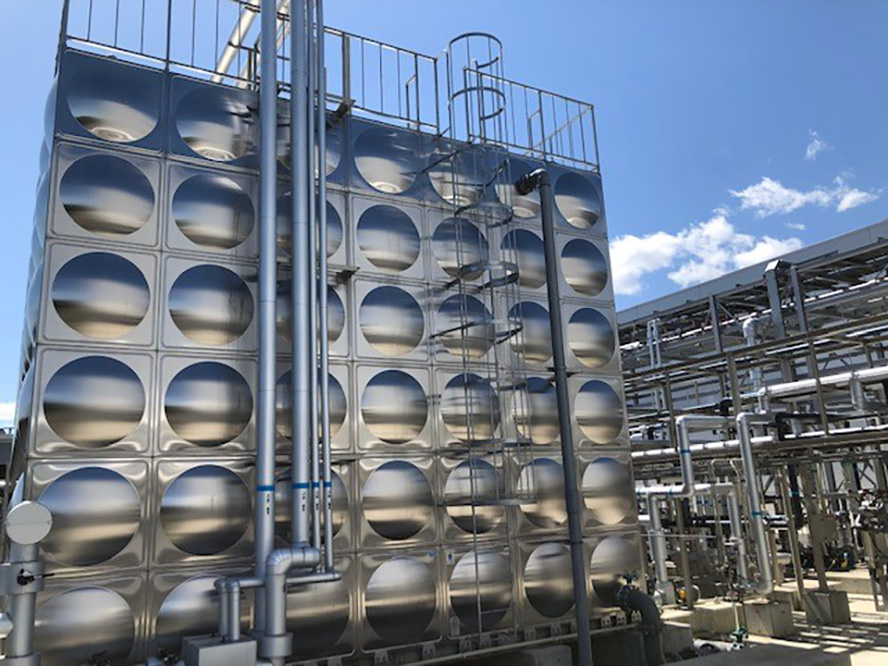
Water treatment facilities at Nasu factory (Japan)
In addition, we are identifying locations and facilities with high water usage by increasing the number of monitoring points (measurement points) for water usage in our factories. The water usage of all factories is reported monthly, and we have established a system to track progress towards our targets and to develop measures to achieve them.
For instance, at our Kakegawa factory, we analyze data from measurement points and conduct training for environmental representatives in each workplace to identify the areas for water consumption reduction and find solutions. This initiative has raised our employees' awareness regarding water conservation, resulting in the development and execution of effective measures to reduce water consumption.
To ensure more effective use of water, we focus on circular systems that clean water and reuse or recycle it within the process.
At our Kakegawa factory, we launched a Discharged Water Recycling System in 2023. With this system, we recycle some of the discharged wastewater to use it as makeup water. At our Osaka Ibaraki factory, we introduced a circular system that utilizes re-used water to cool the manufacturing tanks. At our Nasu factory, we optimized our pure water manufacturing equipment, which consumes approximately half of all water used at the factory. We also installed a reverse osmosis system to recycle wastewater.
As a new initiative starting in 2024, efforts are also being made at our overseas factories in Hsinchu and Shanghai to reuse wastewater from our water purification and air conditioning condenser systems to cool manufacturing equipment. Collected rainwater is used to water plants at the sites.
At our Gien factory in France, we switched from water-based cleaning to alcohol-based cleaning for our fragrance manufacturing equipment and transportation components. The alcohol used is cleaned and reused in the process repeatedly.
Water Stewardship (Initiatives on Water Resources in Communities)
We are engaged in the management of water resources as the common property of the water basin, including secondary use in cooperation with communities and initiatives set up with suppliers.
In the area around our Val de Loire factory in France, rainfall volumes are expected to fall in future. Therefore, we regularly share information with other local industries on good water practices to decrease water consumption. At our Shanghai factory in China which is located in a water-stressed* area̶ we participate in a local environmental protection association and proactively obtain environmental information, such as environmental laws and regulations regarding factory activities.
We also report monthly water consumption to the government, which promotes water conservation and is working to improve water utilization rates and strengthen water conservation management.
At our Nasu factory, we use groundwater pumped up from a water-bearing layer that lies 150 meters below the ground surface. We treat wastewater appropriately to conform to our own strict standards before releasing it. The water is then reused as agricultural water. We are carrying out surveys of surrounding areas so that we can better understand the water environment of the entire basin. In addition to computer simulation, in 2024, we investigated how water from the surrounding countryside infiltrates into the ground with the support of a local high school and farmers.
The Osaka factory, located on the banks of the Kanzaki River, has been part of the "Osaka Adopt River Komatsubashi" agreement with Osaka Prefecture since 2002. As part of the Kanzaki River Clean Campaign, the factory collaborates with local groups, companies, and government agencies to conduct cleaning activities. In 2024, a total of 47 employees and their families participated in these efforts.
Additionally, as part of Shiseido's voluntary initiatives, we recruited volunteers from employees both at the Osaka factory and the Osaka Ibaraki factory to conduct environmental beautification activities around a 1.2 km stretch of the Kanzaki River. In 2024, these activities were conducted four times throughout the year, with a total of 236 participants collecting 56 kg of waste. These efforts not only enhance participants' awareness of environmental conservation but also contribute to creating a rich river environment that is cherished by the local community.
In the supply chain, we conduct initiatives to reduce water consumption. For example, we visited the factory of a strategic supplier and advised them to use treated wastewater whose quality has been verified instead of industrial-grade municipal water to rinse equipment. This enabled the recycling of water and led to a reduction in water consumption.
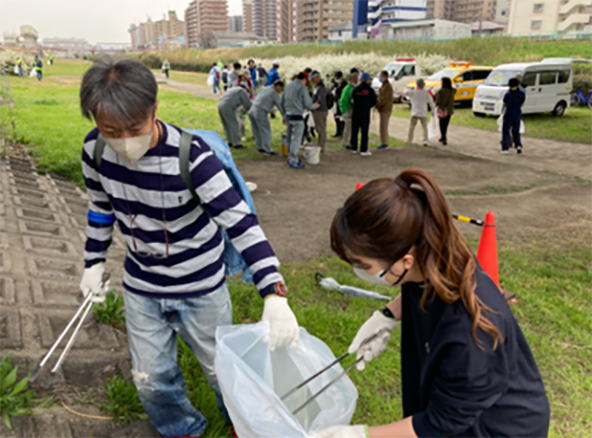
The 19th Kanzakigawa Clean-Up Campaign
- *A situation where there is not enough water of sufficient quantity to meet the demands of people and the environment.
Efforts to Protect Biodiversity at Our Sites
In 2024, the 3.45-hectare green zone owned by the Kakegawa factory was certified as a Sustainably Managed Natural Site by the Ministry of the Environment ("Shiseido Kakegawa Sustainably Managed Natural Site"). The goal of this certification is to increase the number of sites where organizations are making efforts to protect biodiversity. The certification system was developed to achieve the 30by30 target, which aims to protect or conserve at least 30% of land and sea areas by 2030, to support the Kunming-Montreal Global Biodiversity Framework.
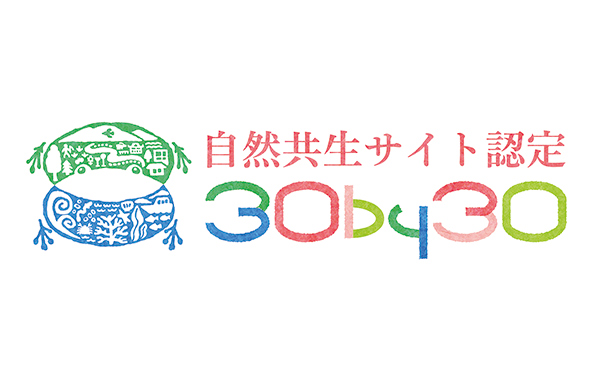
The area is covered by trees that provide a habitat for a variety of native species. Children at KANGAROOM Kakegawa, an onsite childcare facility, visit the area to collect plants and interact with wildlife. Visitors can also admire the beautiful view from the nearby Shiseido Corporate Museum. The area has become a source of joy as well as brand communication. The certification body has recognized these benefits. We will continue to manage the green zone and carry out special surveys to monitor wildlife.
Bees play an important role in the pollination of crops. There are concerns around the declining population of honeybees. So our Val de Loire and Gien factories in France have incorporated the protection of honeybees and the conservation of ecosystems into their sustainability plans. As well as setting up beehives onsite, both factories prohibit the use of agrochemicals on factory grounds. In 2024, the factories’ beehives produced around 86 kg of honey.
To conserve biodiversity, we are growing native plants on a 13,300 m2 plot of land near our factory in the United States. We are also planning to conclude an agreement with a beekeeping company in 2025. As pollinators, bees released on the site will help plants reproduce, which contributes to the conservation of biodiversity.
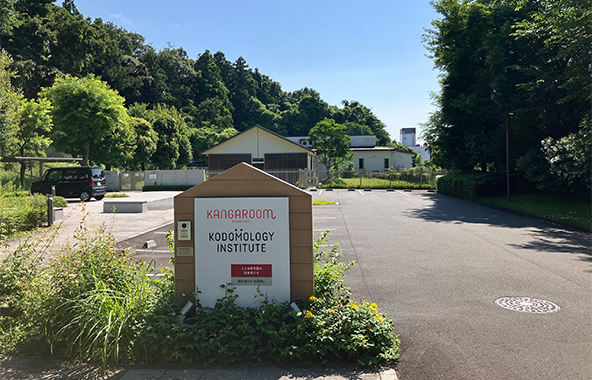
KANGAROOM Kakegawa
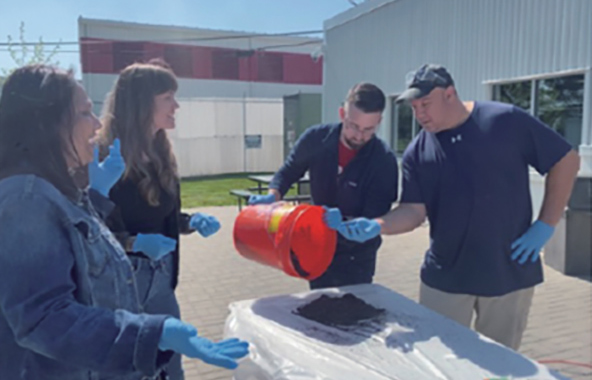
Activities on Earth Day
Climate/Nature-related Financial Disclosure Initiatives
Given the seriousness of the impact of climate change and biodiversity loss on business growth and environmental sustainability, Shiseido has been disclosing information with reference to the framework of TCFD and ISSB for climate issues as well as nature-related information based on TNFD framework and LEAP approach. We conducted qualitative and quantitative analyses of the climate-related risks and opportunities associated with the transition to a decarbonized society and changes in the natural environment due to climate change for both the 1.5/2℃and 4℃scenarios, as well as our major actions, over the short, medium, and long term. Regarding the natural environment, we identified quantitative long-term risks in consideration of biodiversity loss and dynamic states of water resources and disclosed them in the Shiseido Climate/Nature-related Financial Disclosure Report.
Governance
Shiseido is promoting sustainability initiatives through our brands and regional businesses. Sustainability Committee was set up to ensure timely management decisions related to sustainability efforts and their proper implementation across the Group. In 2023, the committee was held regularly. The committee decides on Group-wide sustainability strategies, policies, and discusses specific topics such as risks and opportunities related to climate change and the natural environment, and actions for human rights, as well as monitors the progress of medium-to-long-term goals. The committee consists of the representative corporate executive officers and executive officers in charge of Corporate Strategy, Research & Development, Supply Network, Corporate Communications, and our Brand Holders, to discuss a range of issues from different perspectives. Important matters in the execution of business, which require approvals are proposed or reported to the Global Strategy Committee or the Board of Directors.
In order to ensure executing and promoting of sustainability actions, a Sustainability TASKFORCE was set up under the Sustainability Committee, consisting of the heads of key relevant functions. At the Sustainability TASKFORCE, practical approaches to achieve our long-term targets are discussed with relevant functions, regional headquarters, and local subsidiaries as necessary.
Strategy
We conducted our scenario analysis for both the transitional and the physical risks/opportunities in terms of the 1.5/2℃ and 4℃ scenarios, respectively, based on the Representative Concentration Pathways (RCPs) and Shared Socioeconomic Pathways (SSPs) provided by the IPCC. Regarding transitional risk, the elements associated with the transition to a decarbonized society — such as policy, regulation, technology, market, and consumer perceptions — were considered. Physical risks related to the acute or chronic phenomena caused by the rise in temperature — such as floods and water shortages — were also considered. Based on these considerations, the financial impacts of the 1.5/2℃ and 4℃ scenarios were then analyzed.
The influence of carbon tax was identified as the transition risk, with projections pointing toward approximately JPY 50-870 millionin 2030. For physical risks, JPY 890 millionof floods and JPY 3.2 billion of water shortage were forecasted potentially. As for opportunities, in the 1.5/2℃ scenario, high awareness by consumers means there is a market for sustainable brands and products. Similarly, the 4℃ scenario identifies sales opportunities for products that can help people to live with high temperatures. At Shiseido, we aim to leverage these findings — by mitigating risks and making the most of opportunities to provide sustainable products to consumers and promote our beauty innovations.
Risks and Opportunities
| |
Risks | Opportunities | |
|---|---|---|---|
| Transition (seen mainly in the 1.5/2℃ scenario) |
|
|
|
| Physical (seen mainly in the 4℃ scenario) |
Acute |
|
|
| Chronic |
|
||
- ●Risk factor analyzed qualitatively and quantitatively.
For nature-related risks and opportunities, we conduct a quantitative analysis of the impact on biodiversity throughout the value chain by means of a Life Cycle Assessment. This revealed that the impact is great, particularly in raw material procurement. In response, we assumed places of origin of cosmetics raw materials with high dependence on biodiversity in line with the LEAP approach recommended by TNFD and evaluated the potential impacts due to land conversion. We thus monetized ecosystem services by pollinators, such as honey bees, as physical risk analysis in the aspect of dependencies. At the same time, we analyzed risks on sustainability-related regulations as transitional risks along with climate change issues.
Risk Management
We assess and identify the impactful risks holistically from a mid-to-long-term perspective. “Environmental (Climate Change, Biodiversity, etc.)” and “Natural Disaster, Infectious Disease and Terrorism” are listed as the categories related to sustainability. Climate-related and biodiversity-related risks are analyzed based on scientific and socioeconomic evidence and integrated into the enterprise risk management system as one of the elements related to climate change or natural disasters. According to their significance, the risks and their countermeasures are deliberated by the Global Risk Management & Compliance Committee and the Global Strategy Committee. The material risks are also proposed or reported to the Board of Directors as necessary.
Metrics and Targets
In order to mitigate the climate-related risks, we set the reduction of CO₂ emissions as our target. We aim to achieve carbon-neutrality*1 by 2026 for Scope 1 and Scope 2 emissions. For CO₂ emissions reduction targets of the overall value chain, our 2030 target, which conforms to the 1.5°C trajectory, was accredited by SBTi*2 as a science based target, and we are working to reduce CO₂ emissions. With regard to biodiversity, we are replacing paper and palm-derived raw materials, which have a large impact, with certified raw materials. To reduce Scope 1 and 2 CO₂ emissions, we decided to introduce an internal carbon pricing (ICP) system in 2023 and began to apply it for making decisions on decarbonization investments in energy-efficient facilities, renewable energy facilities, and the similar.*3
- *1:Scope 1 and Scope 2 emissions are the targets. Carbon offsets made by using credits are included.
- *2:SBTi is a global initiative that defines and promotes best practice in science-based target setting and independently assesses companies’ targets.
- *3:ICP price as of 2024: USD 130.0/t-CO₂
Issue Shiseido Climate/Nature-related Financial Disclosure Report
In July 2025, we issued "Shiseido Climate/Nature-related Financial Disclosure Report."
Shiseido Climate/Nature-related Financial Disclosure Report[PDF:2.46MB]
ABOUT US
- Who we are
- History
- Profile
- Governance
- Quality Management
- Supply Network
- Region/Business
BRANDS
- Prestige
- Premium
- Inner Beauty
- Life Quality Makeup
SUSTAINABILITY
- Strategy / Management
- Society
- Environment
- Governance
- Reports / Data
- Related Information
INNOVATION
- Research and Development
- Research Areas
- Research outcomes
- Product safety
- Product Development Policy
- Initiatives for doctors and researchers
CAREERS
INVESTORS
- IR Library